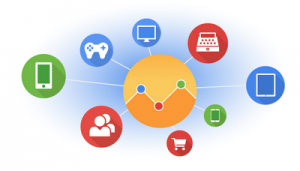 Last week, Google Analytics made a BIG announcement about changes to Google Analytics. One of the fundamental changes to Google Analytics is the introduction of universal analytics. It sounds important, but what does it really mean?
Last week, Google Analytics made a BIG announcement about changes to Google Analytics. One of the fundamental changes to Google Analytics is the introduction of universal analytics. It sounds important, but what does it really mean?
-
- Users no longer rely on one device to engage with the brand. Quite often, users rely on array of different tools to engage with the brand – computer, smartphone, tablet, game console, digital display are some of the tools that facilitate the relationship and engagement. The question is how do we track our audience across all these devices without losing any data? This concept is the basis for universal analytics.
-
- More channels mean more data, and cross-channel measurement is more important than ever. It is imperative for companies to track and measure their relationship with customers between these channels. The new Measurement Protocol (API) within Google Analytics will allow companies to send their measurement data to Google Analytics. With Universal Analytics, you will be able to track data from your online and offline customer touch points.
-
- Let’s discuss the technical aspect of this change as Google is planning to implement this. Currently, Google Analytics is relying on “cookies” and “sessions” to track visitors. Universal analytics moves away from tracking sessions and will instead track users using universal IDs. This will help you link all the data related to each user. This means – no matter what device the user is employing, you will be able to track them using one anonymous ID.
-
- Let’s discuss this anonymous ID. Google clearly states “Don’t use personally identifiable data in your Google Analytics account”. However, this is where integration with the CRM is imperative. An Anonymous ID used in Google Analytics will be associated with the contact in the CRM. This way, you will be able to track all different types of data: online activity, call center data, retail purchases, etc.
-
- Let’s consider an example. Maroon 5 is in town. I go to the concert website and purchase a ticket. The ticket is printed with a unique ID. I go to the concert and, the staff scans my ticket. During the concert, I visit a shop to buy a Maroon 5 t-shirt. As I make the purchase my ticket is being scanned as well. After the concert, there is an announcement that if I purchase a ticket to Maroon 5′s next concert withing 3 days, I will get 10% off. Being a Maroon 5 addict, I decide to complete the purchase immediately using my smartphone. In order to get my 10% off, I am asked to enter my ticket ID. Let’s connect the dots – all my online and offline activity has now been tracked using one Anonymous ID. Everything now can be tracked in Google Analytics – from how I came to the site the first time, to how I completed my purchase, to how I behaved at the concert, to my purchasing behavior after the concert. As the next step, concert organizers can put all this data in their CRM and have a complete picture of my behavior. Finally, they can decide to invite me to other Maroon 5 events or email me specials about Maroon 5 posters.
-
- And one more thing… Now, you can also import cost data into Google Analytics. Currently, this is only available with AdWords. Soon, you will be able to import cost data associated with each campaign. This will help measure true marketing ROI.
-
- Can I try? The short answer is not yet. This is still in Beta and rolling out slowly. However, you can request Measurement Protocol Closed Developer Review.
Summary
If you do not get selected to try this feature first, you will be able to experience it along with everyone else pretty soon. Take this time to think about this change and how it will affect your business. This can have a very positive effect on your marketing efforts, but first you need to map-out all your data points, ways you interact with customers right now and how you will be able to integrate this data together.




